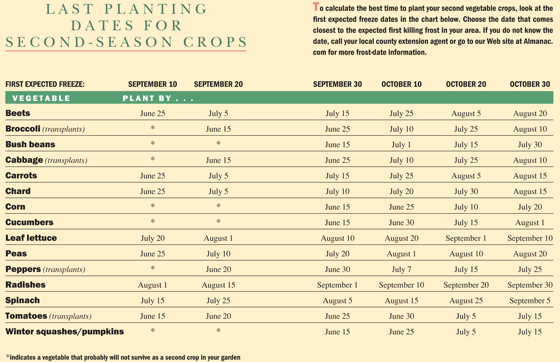Plant a second crop in the gaps left behind!
What is succession planting? It’s simple! When your first crops are finished, make the most of the limited space and plan out second (or third!) plantings. After all, your bed’s already prepared! See which veggies are best for another planting—so it harvests before frost comes!
What is Succession Planting?
With succession planting, you enjoy multiple harvests from a single patch of ground in any given growing season. This is done by planting one crop immediately after an earlier crop has finished to keep the harvests coming. So, you are planting two or more crops in “succession.”
Growing like this not only maximizes productivity, ensuring more for you to eat, but maintaining soil cover with the leaves and roots of crops also provides fewer opportunities for weeds, while protecting the ground from erosion caused by wind and heavy rain.
Many vegetables need only half the growing season to reach harvest time, leaving plenty of fine weather to start off a crop that will either be harvested before the end of the season, or remain in the ground to give a crop over the winter or spring.
Sow the Right Crops
Vegetables that can be followed with a successional crop include:
- bush beans,
- early potatoes
- carrots,
- onions,
- garlic,
- beets
- many salad greens
When these first spring crops are harvested, you can make way for the second crops of the season. These vegetables will be able to take advantage of the warm soil and high light levels to quickly grow away.
Before planting the second crop, clean the ground of any weeds then use a rake to break up any clumps and tamp the soil down before raking flat. Good, rich soil that had organic matter added for the previous crop shouldn’t require any more, but if your soil does need a boost now’s the time to add a thin layer of compost before sowing or planting.
Speed is of the essence, so aim to have young plants or seeds ready to go in immediately after the first crop is cleared, that way you’ll make the most of the valuable warmth that remains this summer.
Succession Crops
Some crops may need to be planted out as young plants from sowings made earlier on, or from transplants, to ensure they reach harvesting stage before the season ends. These include many of the cabbage family plants such as kale, cauliflower and cabbage, plus Florence (bulbing) fennel, beets and lettuce. Some will be harvested in the fall, while others will give a small crop in winter before the main harvest in spring.
Plants to grow from seed include chard, Oriental vegetables such as bok choy, herbs like parsley and cilantro, and salad greens such as endive, spinach and arugula.
Planning for Succession Crops
Planning your successional sowings and plantings in advance will make it a lot easier to work out what can follow on from what.
Here’s a list of common vegetables that can be planted in succession, as well as suggested planting dates based on your usual first fall frost date:
For planting dates tailored to your area, check out our Garden Planner’s Succession Planting feature to help you to plan where and when to sow your successional crops. Start by double clicking on a crop to bring up the plant edit box. Now set the dates it will be in the ground. Repeat for all your crops.
You can now view your garden plan in a particular month, which will show you where gaps appear as earlier crops are harvested. The filter button can then be used to narrow down the choice of crops for starting off in that month: either narrow down to those suitable for sowing or planting by month, or select the ‘Suitable for Fall Planting/Harvesting’ button. It’s now easy to see where you can add the plants you want to grow to your garden plan.
Summer Sowing Tips
Direct sowings in the height of summer can be challenging in hot weather, particularly for leafy vegetables and salads such as chicory and spinach that need cooler soil temperatures to germinate. You can improve conditions by watering into seed drills before sowing to cool the soil down. Repeat two more times if the soil is especially dry. Doing this also creates a moist environment around the seeds.
Sowing under shade cloth can help, or sow into plugs of potting soil in a shady corner to plant out once the soil’s cooled down towards the end of summer.
Some plants such as kale and other brassicas can struggle in the heat. A simple shade cover will help to keep conditions that little bit cooler.
Careful successional sowing and planting can ensure a steady stream of year-round harvests. As always, we’d love to hear your experiences of succession planting – drop us a comment below and tell us what you’re growing.
ADVERTISEMENT
We harvest white potatoes - Kennebec - in early August and replant with Blue Lake green beans, and get a harvest before frost here in central PA zone 6B.
With this late bean crop we don't have the problem with bugs.
EL, brown spots could possibly be down to a nutrient deficiency, though it's hard to tell without seeing the leaves. I would suggest, either way, that you feed your peppers regularly with a balanced feed specifically aimed at fruiting vegetables - a simple liquid tomato feed would be perfect. As well as containing potassium for flower and fruit production, this will also include micronutrients that can sometimes be depleted.
Hi Charles - It seems you have perfected the art of succession cropping. I hope your contender bush beans are growing well and still promising a delicious crop.
Granmommy - What a speedy result you've had with your peas - they can get a move on when they want too! I hope they produce a bumper harvest for you!
I planted 6 rows of green beans in the spring and after they were done at the end of July, I planted 4 rows of early contender bush bean that should be ready the middle of Sept.
I tilled 3 rows for purple hull peas and zipper cream peas mid August because of our longer growing season In Ragley, Louisiana. Wanting to be sure we made a crop, I presprouted my pea seeds in my oven (off) with the light on. I rinsed my seed in warm water and placed in a cake pan. Then I covered them with a double layer of paper towel dipped in warm water and wrung out lightly. I placed them in the oven with only the light on (40 watt) and left them alone for a day, rinsed in warm water again and by the afternoon of the 2nd day had some seed roots appearing. I then opened the first row on that Wednesday afternoon, wet the V with the water hose completely soaking the soil in the V. Then I carefully laid each sprouted seed into the V and gently covered them with soil and lightly patted it down, rewetting the topsoil...by Friday afternoon I had the first row of peas up and was tickled about it. We have had Hurricane Laura decimate the Gulf Coast now when my peas were about 2-3 inches tall. I left for my Daughter's in Mississippi but my neighbor did not evacuate for the storm and told me today that my peas are still up and growing!!!
Just wondering if my soil does not have nutrients?

 Click for a larger version.
Click for a larger version.







